Wind Variation near the Black Sea Coastal Areas Reflected by the ERA5 Dataset
Abstract
:1. Introduction
- (a)
- What is the range of wind turbines to be installed in this region according to the expected rated wind speed;
- (b)
- Provide a classification of the onshore and offshore sites by using a multicriteria approach that involves various indicators such as average wind speed, monthly variations, or distance from the coast;
- (c)
- Identify the performances of two wind turbines (rated at 2.5 MW and 20 MW) that may involve monopile or floating foundations.
2. Materials and Methods
2.1. Target Area
2.2. Wind Data and Indicators
3. Results
4. Discussions
5. Conclusions
- (a)
- According to the evolution of the VmaxE indicator, the rated wind speed of a wind turbine should be located in the range of 3.5–11.5 m/s on a general scale, with higher values being related to an offshore wind generator. During wintertime, a generator operating near a rated speed of 12.8 m/s may be considered efficient for most of the marine areas (100 km from the shore);
- (b)
- By applying a multicriteria decision, it was found that the marine site located close to the Odessa area (Ukraine) presents wind conditions rated as outstanding (class C6), while during autumn and winter, some other sites are included in this category, for example, Constanta, Romania;
- (c)
- As expected, a wind turbine rated at 20 MW (marine version) will have a higher electricity production, compared to a 2.5 MW generator (onshore version), indicating also better performances in terms of the capacity factor.
Author Contributions
Funding
Acknowledgments
Conflicts of Interest
References
- Zou, C.; Ma, F.; Pan, S.; Lin, M.; Zhang, G.; Xiong, B.; Wang, Y.; Liang, Y.; Yang, Z. Earth Energy Evolution, Human Development and Carbon Neutral Strategy. Pet. Explor. Dev. 2022, 49, 468–488. [Google Scholar] [CrossRef]
- Jia, Z.; Wen, S.; Lin, B. The Effects and Reacts of COVID-19 Pandemic and International Oil Price on Energy, Economy, and Environment in China. Appl. Energy 2021, 302, 117612. [Google Scholar] [CrossRef] [PubMed]
- Bento, P.M.R.; Mariano, S.J.P.S.; Calado, M.R.A.; Pombo, J.A.N. Impacts of the COVID-19 Pandemic on Electric Energy Load and Pricing in the Iberian Electricity Market. Energy Rep. 2021, 7, 4833–4849. [Google Scholar] [CrossRef]
- Boosting Offshore Renewable Energy. Available online: https://ec.europa.eu/commission/presscorner/detail/en/IP_20_2096 (accessed on 23 June 2022).
- Wind Energy in Europe: 2021 Statistics and the Outlook for 2022–2026|WindEurope. Available online: https://windeurope.org/intelligence-platform/product/wind-energy-in-europe-2021-statistics-and-the-outlook-for-2022-2026/ (accessed on 23 June 2022).
- Enevoldsen, P.; Valentine, S.V. Do Onshore and Offshore Wind Farm Development Patterns Differ? Energy Sustain. Dev. 2016, 35, 41–51. [Google Scholar] [CrossRef]
- Saenz-Aguirre, A.; Saenz, J.; Ulazia, A.; Ibarra-Berastegui, G. Optimal Strategies of Deployment of Far Offshore Co-Located Wind-Wave Energy Farms. Energy Convers. Manag. 2022, 251, 114914. [Google Scholar] [CrossRef]
- Raileanu, A.; Onea, F.; Rusu, E. An Overview of the Expected Shoreline Impact of the Marine Energy Farms Operating in Different Coastal Environments. J. Mar. Sci. Eng. 2020, 8, 228. [Google Scholar] [CrossRef] [Green Version]
- Dawn, S.; Tiwari, P.K.; Goswami, A.K.; Singh, A.K.; Panda, R. Wind Power: Existing Status, Achievements and Government’s Initiative towards Renewable Power Dominating India. Energy Strategy Rev. 2019, 23, 178–199. [Google Scholar] [CrossRef]
- Rusu, L.; Ganea, D.; Mereuta, E. A Joint Evaluation of Wave and Wind Energy Resources in the Black Sea Based on 20-Year Hindcast Information. Energy Explor. Exploit. 2018, 36, 335–351. [Google Scholar] [CrossRef]
- Kubryakov, A.; Stanichny, S.; Shokurov, M.; Garmashov, A. Wind Velocity and Wind Curl Variability over the Black Sea from QuikScat and ASCAT Satellite Measurements. Remote Sens. Environ. 2019, 224, 236–258. [Google Scholar] [CrossRef]
- Onea, F.; Rusu, E.; Rusu, L. Assessment of the Offshore Wind Energy Potential in the Romanian Exclusive Economic Zone. J. Mar. Sci. Eng. 2021, 9, 531. [Google Scholar] [CrossRef]
- Islek, F.; Yuksel, Y.; Sahin, C. Spatiotemporal Long-Term Trends of Extreme Wind Characteristics over the Black Sea. Dyn. Atmos. Oceans 2020, 90, 101132. [Google Scholar] [CrossRef]
- Rusu, E. A 30-Year Projection of the Future Wind Energy Resources in the Coastal Environment of the Black Sea. Renew. Energy 2019, 139, 228–234. [Google Scholar] [CrossRef]
- Amarouche, K.; Akpınar, A.; Soran, M.B.; Myslenkov, S.; Majidi, A.G.; Kankal, M.; Arkhipkin, V. Spatial Calibration of an Unstructured SWAN Model Forced with CFSR and ERA5 Winds for the Black and Azov Seas. Appl. Ocean Res. 2021, 117, 102962. [Google Scholar] [CrossRef]
- Guillory, A. ERA5. Available online: https://www.ecmwf.int/en/forecasts/datasets/reanalysis-datasets/era5 (accessed on 31 May 2019).
- Costoya, X.; de Castro, M.; Carvalho, D.; Gómez-Gesteira, M. On the Suitability of Offshore Wind Energy Resource in the United States of America for the 21st Century. Appl. Energy 2020, 262, 114537. [Google Scholar] [CrossRef]
- Costoya, X.; de Castro, M.; Santos, F.; Sousa, M.C.; Gómez-Gesteira, M. Projections of Wind Energy Resources in the Caribbean for the 21st Century. Energy 2019, 178, 356–367. [Google Scholar] [CrossRef]
- Oh, K.-Y.; Kim, J.-Y.; Lee, J.-K.; Ryu, M.-S.; Lee, J.-S. An Assessment of Wind Energy Potential at the Demonstration Offshore Wind Farm in Korea. Energy 2012, 46, 555–563. [Google Scholar] [CrossRef]
- Belu, R. Fundamentals and Source Characteristics of Renewable Energy Systems, 1st ed.; Series: Nano and energy Series; CRC Press: Boca Raton, FL, USA, 2019; ISBN 978-0-429-29728-1.a. [Google Scholar]
- Shu, Z.R.; Jesson, M. Estimation of Weibull Parameters for Wind Energy Analysis across the UK. J. Renew. Sustain. Energy 2021, 13, 023303. [Google Scholar] [CrossRef]
- Al-Nassar, W.K.; Neelamani, S.; Al-Salem, K.A.; Al-Dashti, H.A. Feasibility of Offshore Wind Energy as an Alternative Source for the State of Kuwait. Energy 2019, 169, 783–796. [Google Scholar] [CrossRef]
- Joian, R.; Lung, C.; Horgos, M. The Experimental Determinations at the Wind Farm Fantanel—Cogealac in Dobrogea. In Proceedings of the 2021 IEEE 27th International Symposium for Design and Technology in Electronic Packaging (SIITME), Timisoara, Romania, 27 October 2021; pp. 369–373. [Google Scholar]
- Qin, C.; Loth, E.; Zalkind, D.S.; Pao, L.Y.; Yao, S.; Griffith, D.T.; Selig, M.S.; Damiani, R. Downwind Coning Concept Rotor for a 25 MW Offshore Wind Turbine. Renew. Energy 2020, 156, 314–327. [Google Scholar] [CrossRef]
- De Souza, C.E.S.; Bachynski-Polić, E.E. Design, Structural Modeling, Control, and Performance of 20 MW Spar Floating Wind Turbines. Mar. Struct. 2022, 84, 103182. [Google Scholar] [CrossRef]
- GE Energy 2.5xl-Manufacturers and Turbines-Online Access-The Wind Power. Available online: https://www.thewindpower.net/turbine_en_59_ge-energy_2.5xl.php (accessed on 10 March 2019).
- Ashuri, T.; Martins, J.R.R.A.; Zaaijer, M.B.; Van Kuik, G.A.M.; Van Bussel, G.J.W. Aeroservoelastic Design Definition of a 20 MW Common Research Wind Turbine Model: A 20 MW Common Research Wind Turbine Model. Wind. Energy 2016, 19, 2071–2087. [Google Scholar] [CrossRef]
- Rusu, E.; Onea, F. A Parallel Evaluation of the Wind and Wave Energy Resources along the Latin American and European Coastal Environments. Renew. Energy 2019, 143, 1594–1607. [Google Scholar] [CrossRef]
- Raileanu, A.B.; Onea, F.; Rusu, E. Implementation of Offshore Wind Turbines to Reduce Air Pollution in Coastal Areas—Case Study Constanta Harbour in the Black Sea. J. Mar. Sci. Eng. 2020, 8, 550. [Google Scholar] [CrossRef]
- Yildirir, V.; Rusu, E.; Onea, F. Wind Energy Assessments in the Northern Romanian Coastal Environment Based on 20 Years of Data Coming from Different Sources. Sustainability 2022, 14, 4249. [Google Scholar] [CrossRef]
- Fantanele-Cogealac Wind Farm-Power Technology. Available online: https://www.power-technology.com/projects/fantanele-cogealac-wind-farm/ (accessed on 22 June 2022).
- Pereira, F.S.; Silva, C.S. Offshore Wind Energy Resource Assessment from Satellite Data Observations and WRF in Porto Santo Island. Wind. Energy Sci. Discuss. 2020, preprint. [Google Scholar] [CrossRef] [Green Version]
- Archer, C.L.; Jacobson, M.Z. Evaluation of Global Wind Power. J. Geophys. Res. Atmos. 2005, 110, 1–10. [Google Scholar] [CrossRef] [Green Version]
- Li, D.; Geyer, B.; Bisling, P. A Model-Based Climatology Analysis of Wind Power Resources at 100-m Height over the Bohai Sea and the Yellow Sea. Appl. Energy 2016, 179, 575–589. [Google Scholar] [CrossRef]
- Offshore Wind in Europe-Key Trends and Statistics 2020|WindEurope. Available online: https://windeurope.org/intelligence-platform/product/offshore-wind-in-europe-key-trends-and-statistics-2020/ (accessed on 23 June 2022).
- Countries. Available online: https://maritime-spatial-planning.ec.europa.eu/msp-practice/countries (accessed on 23 June 2022).
- Top 10 Biggest Offshore Wind Farms-Power Technology. Available online: https://www.power-technology.com/analysis/feature-top-10-biggest-offshore-wind-farms-uk/ (accessed on 23 June 2022).
- Argin, M.; Yerci, V.; Erdogan, N.; Kucuksari, S.; Cali, U. Exploring the Offshore Wind Energy Potential of Turkey Based on Multi-Criteria Site Selection. Energy Strategy Rev. 2019, 23, 33–46. [Google Scholar] [CrossRef]
- Pantusa, D.; Tomasicchio, G.R. Large-Scale Offshore Wind Production in the Mediterranean Sea. Cogent Eng. 2019, 6, 1661112. [Google Scholar] [CrossRef]
- Wen, Y.; Kamranzad, B.; Lin, P. Assessment of Long-Term Offshore Wind Energy Potential in the South and Southeast Coasts of China Based on a 55-Year Dataset. Energy 2021, 224, 120225. [Google Scholar] [CrossRef]
- Sartori, L.; Bellini, F.; Croce, A.; Bottasso, C. Preliminary Design and Optimization of a 20MW Reference Wind Turbine. J. Phys. Conf. Ser. 2018, 1037, 042003. [Google Scholar] [CrossRef]
- Girleanu, A.; Onea, F.; Rusu, E. Assessment of the Wind Energy Potential along the Romanian Coastal Zone. Inventions 2021, 6, 41. [Google Scholar] [CrossRef]
- Onea, F.; Ruiz, A.; Rusu, E. An Evaluation of the Wind Energy Resources along the Spanish Continental Nearshore. Energies 2020, 13, 3986. [Google Scholar] [CrossRef]
- A European Green Deal|European Commission. Available online: https://ec.europa.eu/info/strategy/priorities-2019-2024/european-green-deal_en (accessed on 22 June 2022).
- Mobil-Grid-CoP. Available online: https://www.iwes.fraunhofer.de/en/research-projects/current-projects/mobil-grid-cop.html (accessed on 22 June 2022).

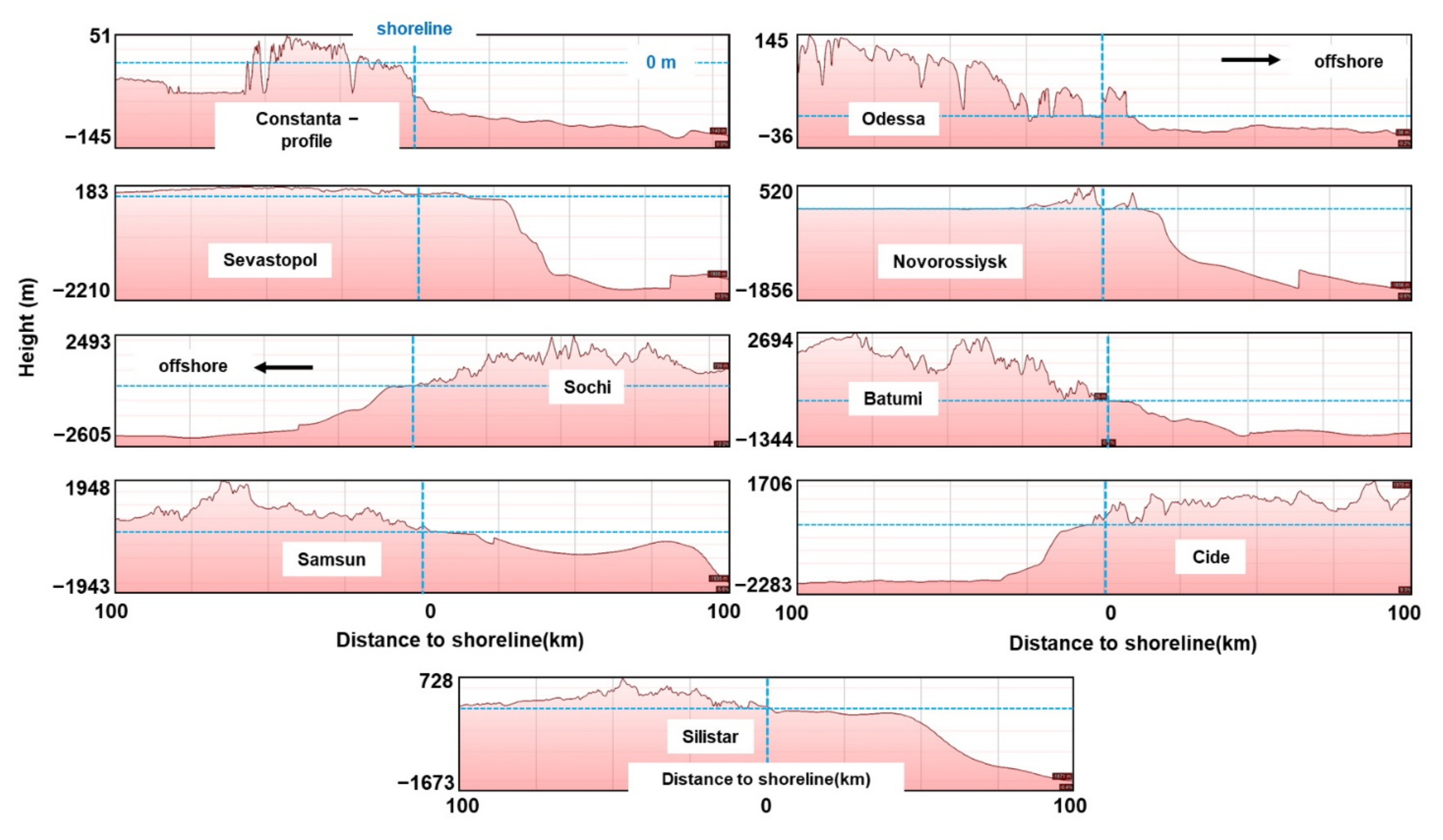
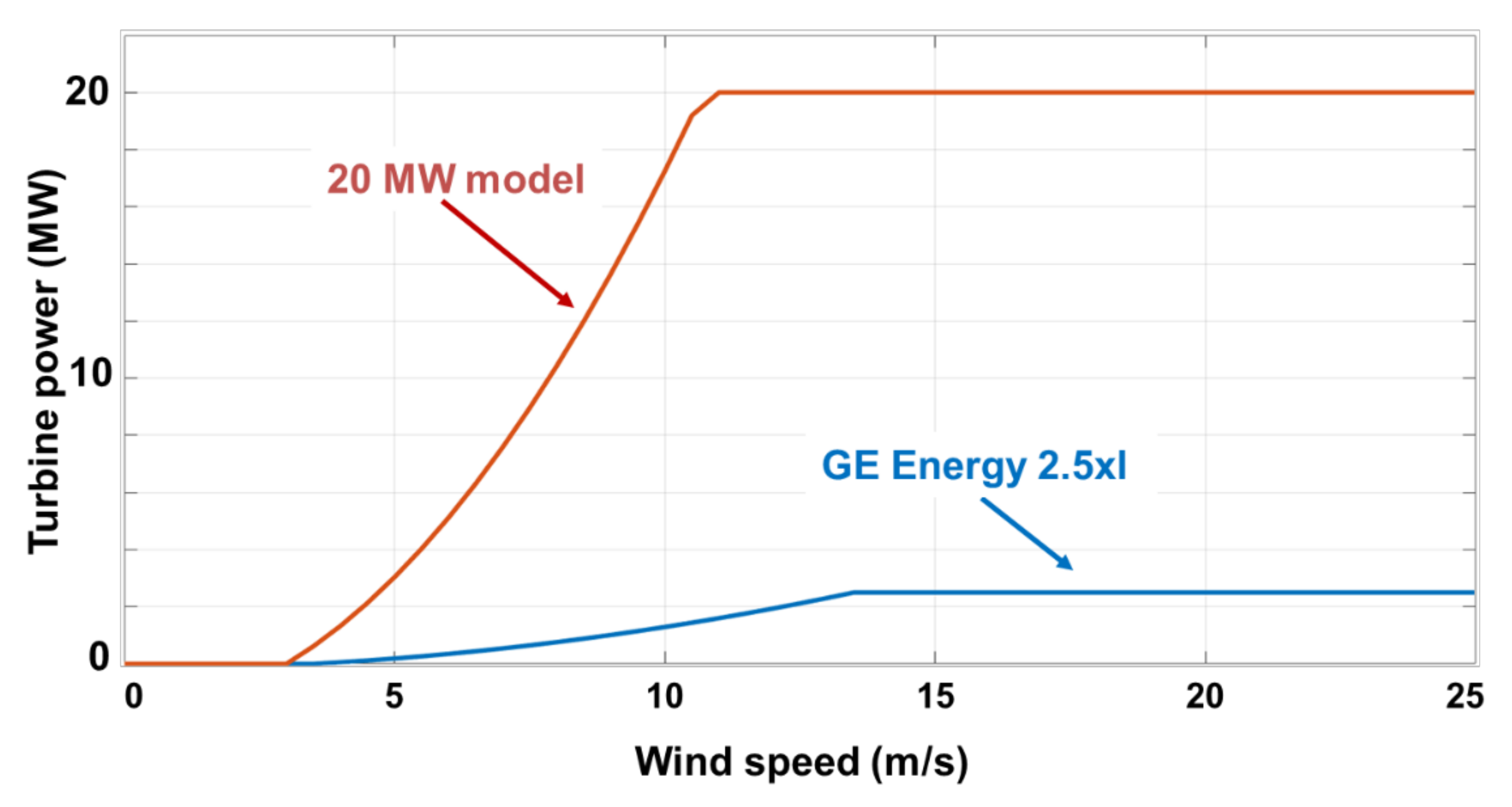

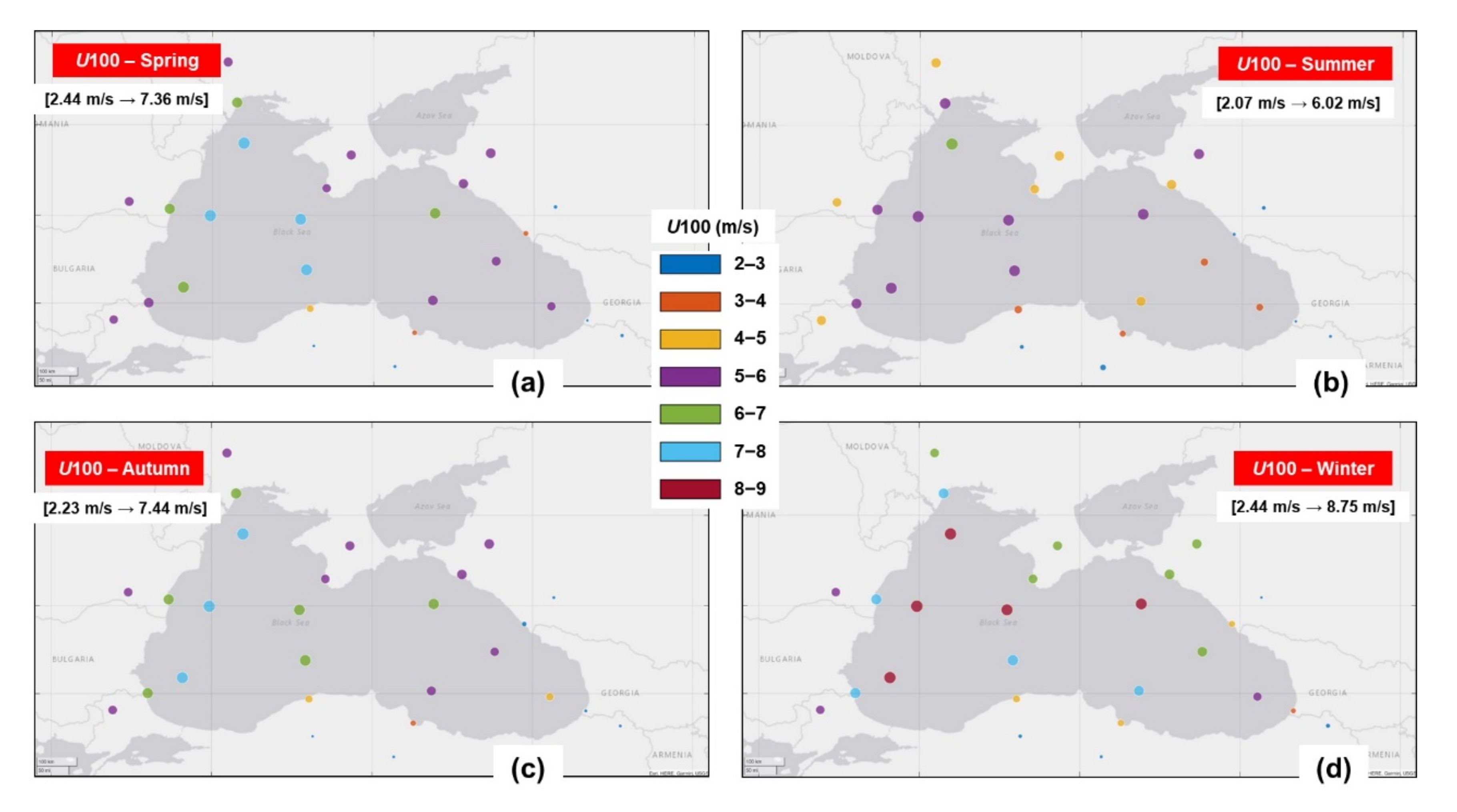


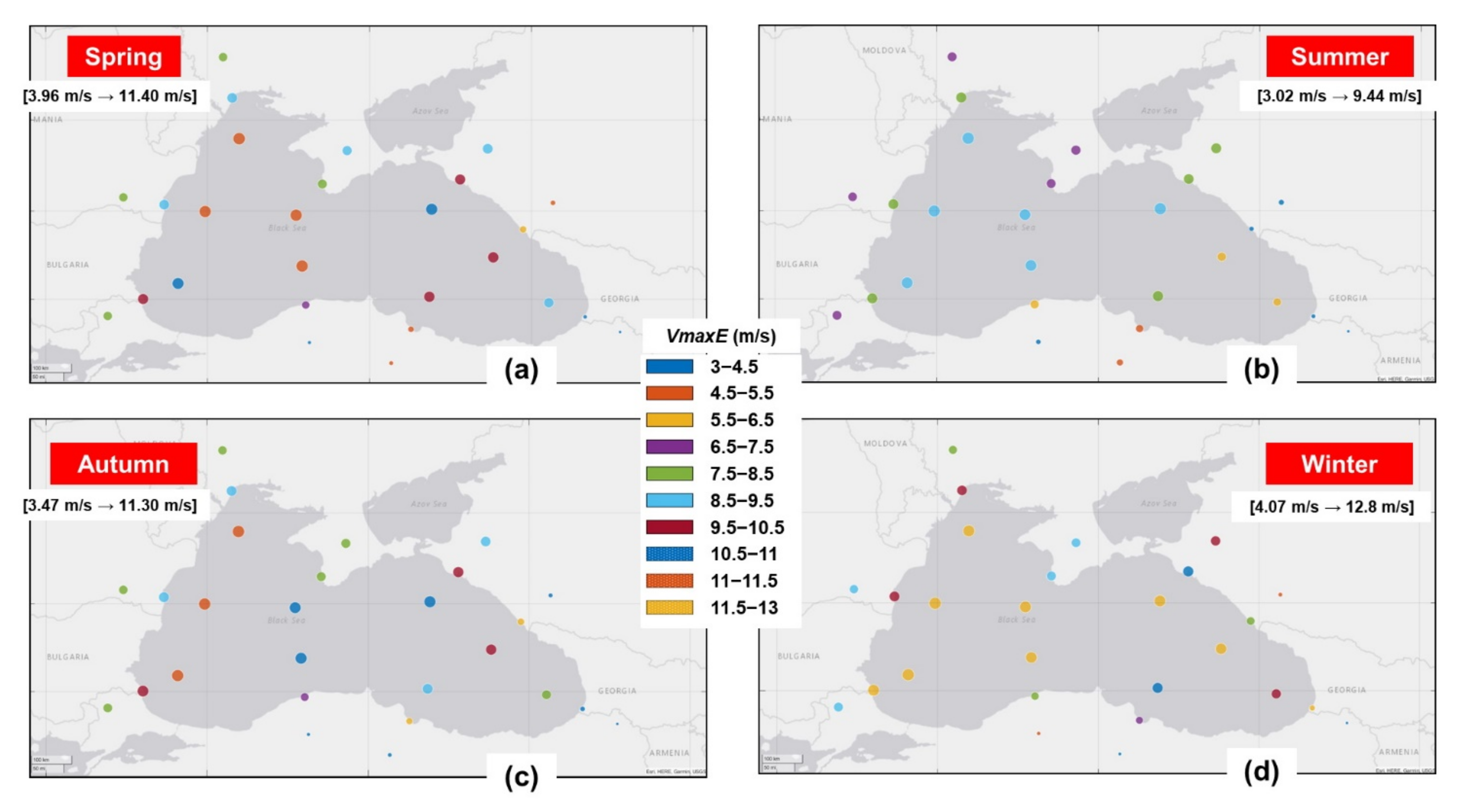
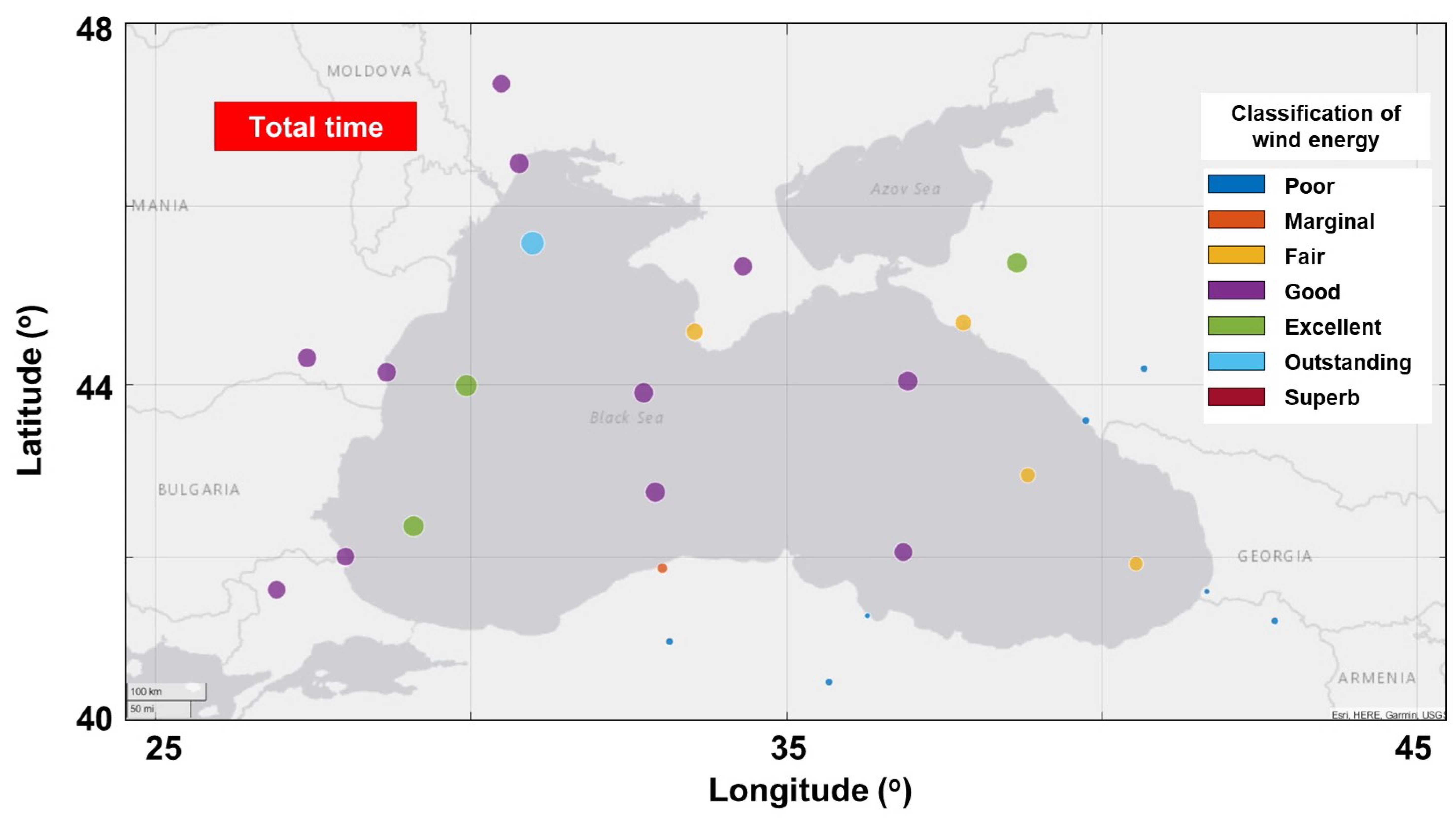

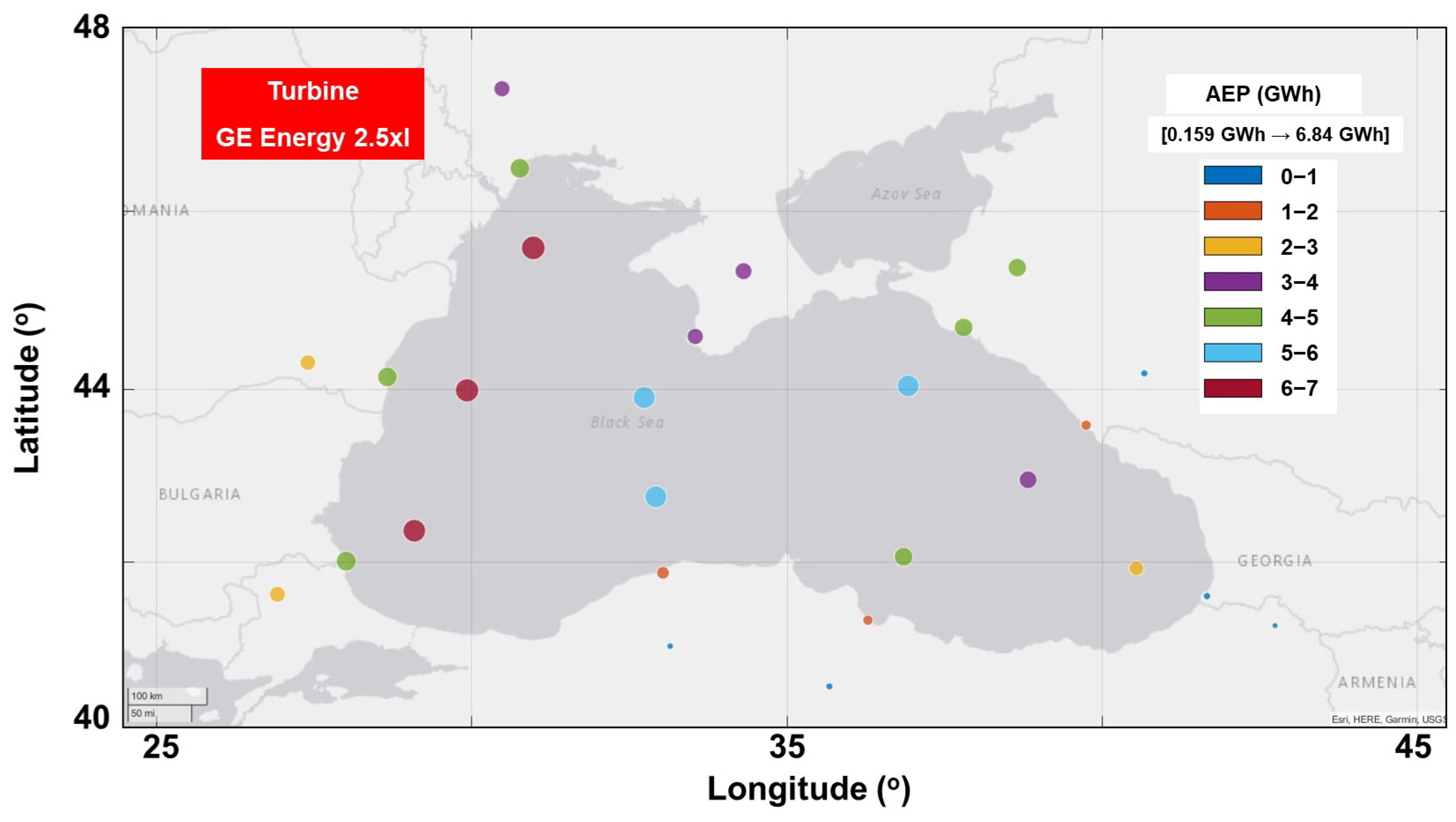
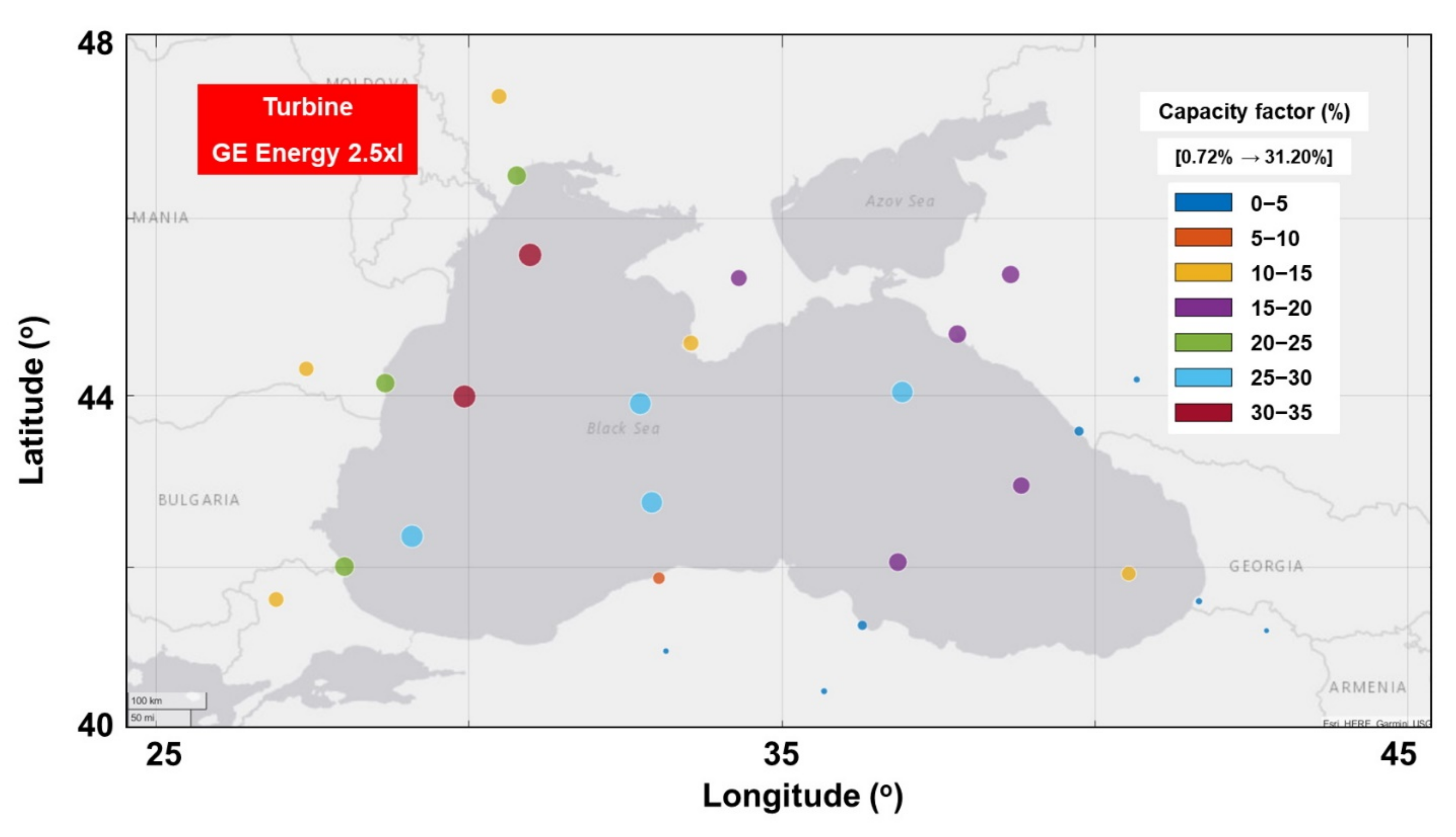
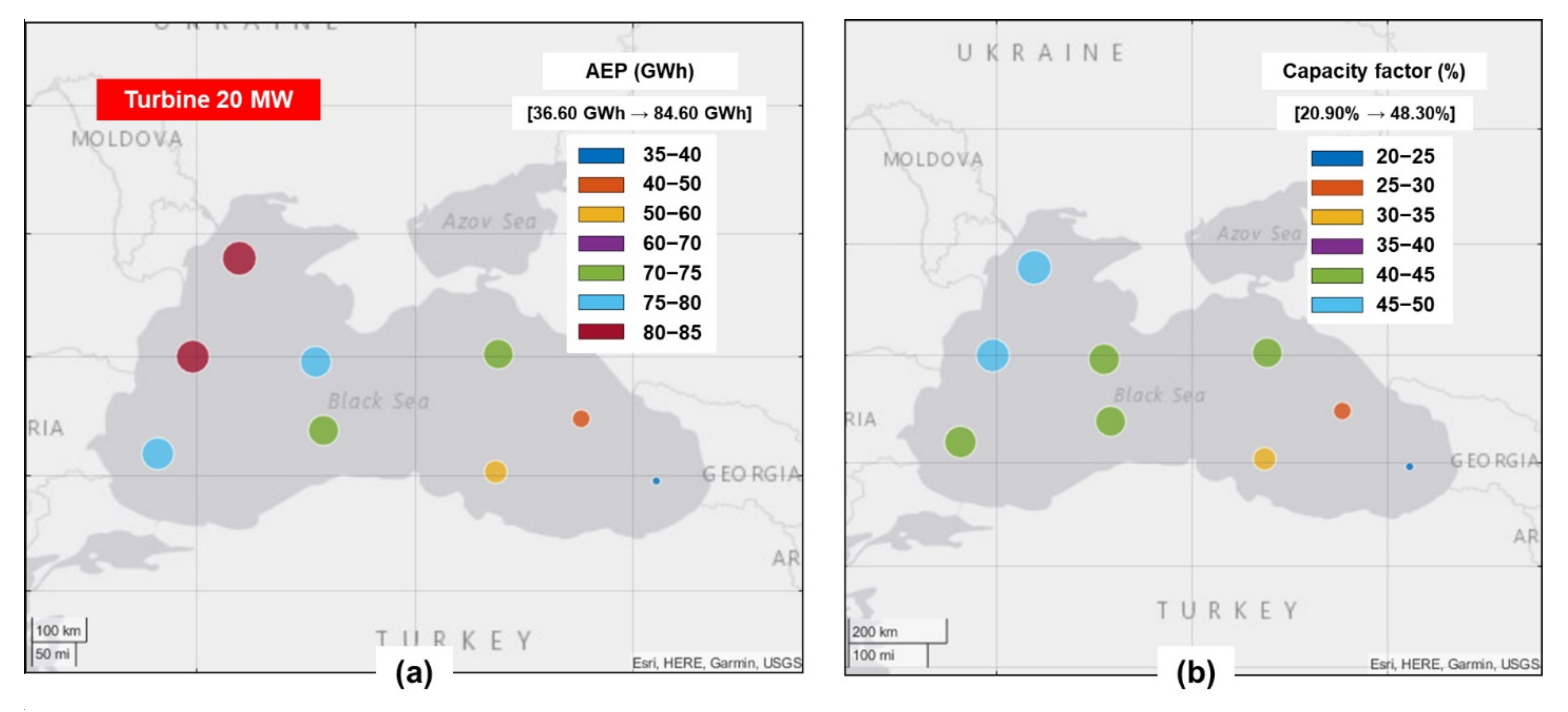
| Site | Lat (°) | Long (°) | Height/Depth (m) |
|---|---|---|---|
| Constanta (RO) | 44.15° | 28.66° | −9 |
| Odessa (UA) | 46.47° | 30.76° | 1 |
| Sevastopol (UA) | 44.60° | 33.55° | 47 |
| Novorossiysk (RU) | 44.70° | 37.81° | 63 |
| Sochi (RU) | 43.59° | 39.75° | 78 |
| Batumi (GA) | 41.60° | 41.66° | 47 |
| Samsun (TR) | 41.31° | 36.29° | 0 |
| Cide (TR) | 41.87° | 33.04° | 216 |
| Silistar (BG) | 42.01° | 28.01° | 17 |
| Wind class | Indicator | Wind Speed (m/s) | WPD (W/m2) |
|---|---|---|---|
| C1 | Poor | <6.1 | <260 |
| C2 | Marginal | 6.1–7.1 | 260–420 |
| C3 | Fair | 7.1–7.8 | 420–560 |
| C4 | Good | 7.8–8.3 | 560–670 |
| C5 | Excellent | 8.3–8.9 | 670–820 |
| C6 | Outstanding | 8.9–9.7 | 820–1060 |
| C7 | Superb | >9.7 | >1060 |
| (a) Normalized Criterion | ||||||||
|---|---|---|---|---|---|---|---|---|
| Normalized Values | EWSO (%) | RLO (%) | Cv | Mv | EWS (m/s) | WD (m) | DC (o) | |
| 0 | <20 | <20 | >1.75 | >1.75 | >28 | >500 | >4 | |
| 0.25 | 20–40 | 20–40 | 1.25–1.75 | 1.25–1.75 | 25–28 | 100–500 | 3–4 | |
| 0.5 | 40–60 | 40–60 | 0.75–1.25 | 0.75–1.25 | 20–25 | 50–100 | 2–3 | |
| 0.75 | 60–80 | 60–80 | 0.25–0.75 | 0.25–0.75 | 15–20 | 25–50 | 0.5–2 | |
| 1 | 80–100 | 80–100 | <0.25 | <0.25 | <15 | 0–25 | <0.5 | |
| (b) Importance of each parameter | ||||||||
| Wann | EWSO | RLO | Cv | Mv | EWS | WD | DC | |
| Weight | 0.22 | 0.22 | 0.1 | 0.1 | 0.05 | 0.14 | 0.07 | 0.1 |
| (c) Resources classification | ||||||||
| Class | 1 | 2 | 3 | 4 | 5 | 6 | 7 | |
| Category | x ≤ 0.4 | 0.4 ≤ x ≤ 0.5 | 0.5 ≤ x ≤ 0.6 | 0.6 ≤ x ≤ 0.7 | 0.7 ≤ x ≤ 0.8 | 0.8 ≤ x ≤ 0.9 | x > 0.9 | |
| Indicator | Poor | Marginal | Fair | Good | Excellent | Outstanding | Superb | |
Publisher’s Note: MDPI stays neutral with regard to jurisdictional claims in published maps and institutional affiliations. |
© 2022 by the authors. Licensee MDPI, Basel, Switzerland. This article is an open access article distributed under the terms and conditions of the Creative Commons Attribution (CC BY) license (https://creativecommons.org/licenses/by/4.0/).
Share and Cite
Yildirir, V.; Rusu, E.; Onea, F. Wind Variation near the Black Sea Coastal Areas Reflected by the ERA5 Dataset. Inventions 2022, 7, 57. https://doi.org/10.3390/inventions7030057
Yildirir V, Rusu E, Onea F. Wind Variation near the Black Sea Coastal Areas Reflected by the ERA5 Dataset. Inventions. 2022; 7(3):57. https://doi.org/10.3390/inventions7030057
Chicago/Turabian StyleYildirir, Victoria, Eugen Rusu, and Florin Onea. 2022. "Wind Variation near the Black Sea Coastal Areas Reflected by the ERA5 Dataset" Inventions 7, no. 3: 57. https://doi.org/10.3390/inventions7030057
APA StyleYildirir, V., Rusu, E., & Onea, F. (2022). Wind Variation near the Black Sea Coastal Areas Reflected by the ERA5 Dataset. Inventions, 7(3), 57. https://doi.org/10.3390/inventions7030057








